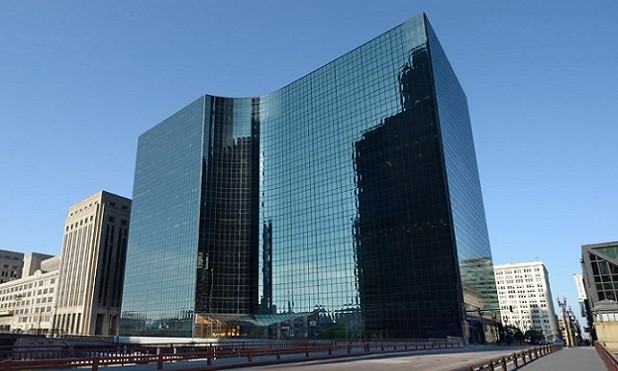
CHICAGO—As the metro Chicago market heads into a period during which office developers will open up several million square feet of new space, tenants in general have remained quite active and eager to expand. With over 542,000 square feet of absorption in the third quarter of 2016, the market has now experienced six consecutive quarters of positive demand, according to the latest report from Newmark Grubb Knight Frank. Year-to-date absorption now stands at 1.7 million square feet, outpacing the 1.4 million square feet of absorption recorded at this point last year.
The metro area's vacancy rate declined 10 bps to 15.6%, hitting a low not seen in more than 10 years and 540 bps below the high-water mark of 21.0% set in mid-2010. One thing that set the quarter off from most others was that class A properties did not drive absorption, largely due to a few suburban vacancies. ConAgra vacated 162,000 square feet, for example, and Redbox gave back 117,000 square feet. As a result, suburban absorption was negative 209,000 square feet for the quarter.
But class B properties more than made up for that shortfall. Leasing activity in that sector accounted for 664,000 square feet. “At the submarket level, the strongest demand for space was in River North, Central Loop, East Loop and Eastern East-West submarkets, totaling 806,000 square feet,” NGKF says.
And that robust demand helped boost the region's overall weighted asking rent. Rents across all property classes increased $0.15 to $27.18, up 0.6% over the second quarter. The average rental rate is up $0.30 year-over-year and has now, after almost eight years of recovery, surpassed the historic high of $27.17 set in late 2008. The third quarter average also marks a 5.1% increase from the $25.87 rate recorded at the bottom of the last cycle in late 2011.
However, the suburbs have been falling behind the CBD when it comes to rental rates. In the CBD, average rents have increased for six consecutive quarters and are at an all-time high of $34.69, increasing $0.19 in the past three months. “CBD rents grew steadily in the early years of the recovery but that pace has accelerated since the start of 2014, since then rents have increased 6.7%,” NGKF says. But suburban rents increased just $0.05 during the third quarter to $21.25. In fact, rents have hovered around the $21-threshold since the recession and are still 3.0% below the high-water mark set in early 2008. And in stark contrast to the CBD, “suburban rents have remained flat over the past two years.”

CHICAGO—As the metro Chicago market heads into a period during which office developers will open up several million square feet of new space, tenants in general have remained quite active and eager to expand. With over 542,000 square feet of absorption in the third quarter of 2016, the market has now experienced six consecutive quarters of positive demand, according to the latest report from Newmark Grubb Knight Frank. Year-to-date absorption now stands at 1.7 million square feet, outpacing the 1.4 million square feet of absorption recorded at this point last year.
The metro area's vacancy rate declined 10 bps to 15.6%, hitting a low not seen in more than 10 years and 540 bps below the high-water mark of 21.0% set in mid-2010. One thing that set the quarter off from most others was that class A properties did not drive absorption, largely due to a few suburban vacancies. ConAgra vacated 162,000 square feet, for example, and Redbox gave back 117,000 square feet. As a result, suburban absorption was negative 209,000 square feet for the quarter.
But class B properties more than made up for that shortfall. Leasing activity in that sector accounted for 664,000 square feet. “At the submarket level, the strongest demand for space was in River North, Central Loop, East Loop and Eastern East-West submarkets, totaling 806,000 square feet,” NGKF says.
And that robust demand helped boost the region's overall weighted asking rent. Rents across all property classes increased $0.15 to $27.18, up 0.6% over the second quarter. The average rental rate is up $0.30 year-over-year and has now, after almost eight years of recovery, surpassed the historic high of $27.17 set in late 2008. The third quarter average also marks a 5.1% increase from the $25.87 rate recorded at the bottom of the last cycle in late 2011.
However, the suburbs have been falling behind the CBD when it comes to rental rates. In the CBD, average rents have increased for six consecutive quarters and are at an all-time high of $34.69, increasing $0.19 in the past three months. “CBD rents grew steadily in the early years of the recovery but that pace has accelerated since the start of 2014, since then rents have increased 6.7%,” NGKF says. But suburban rents increased just $0.05 during the third quarter to $21.25. In fact, rents have hovered around the $21-threshold since the recession and are still 3.0% below the high-water mark set in early 2008. And in stark contrast to the CBD, “suburban rents have remained flat over the past two years.”
© Touchpoint Markets, All Rights Reserved. Request academic re-use from www.copyright.com. All other uses, submit a request to [email protected]. For more inforrmation visit Asset & Logo Licensing.








